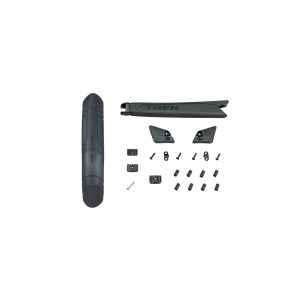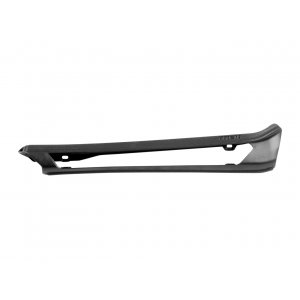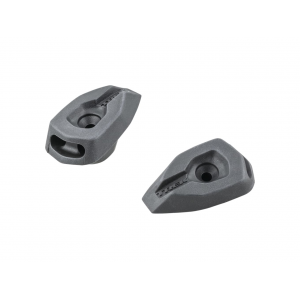2012 Trek Session 9.9
(discontinued)
| Where To Buy | |||
|---|---|---|---|
Free standard shipping on all bikes (continental U.S. only).
Flat rate shipping to Hawaii and Alaska. |
Free standard shipping on all bikes (continental U.S. only).
Flat rate shipping to Hawaii and Alaska. $44.99
|
||
Free shipping on orders over $50 (continental U.S. only).
International shipping available. Some exclusions apply. |
|||
Free shipping on orders over $50 (continental U.S. only).
International shipping available. Some exclusions apply. |
|||
Review by Brandon Turman // Photos by Sterling Lorence
Following the official launch of the Trek Session 9.9 Carbon in Whistler, we've been riding it for nearly one full year. That's a long time for a test bike. The reason? We just can't let go of this one. It's that good. So good, in fact, that we're giving it the illustrious Vital MTB Shreddy for 2012 Bike of the Year.
Inspired and refined in conjunction with Trek World Racing and Aaron Gwin, there's no wonder why this bike rips so much. Their success on the World Cup downhill series is a huge testament to the bike's capabilities.

Session 9.9 Highlights
- Frame Material: OCLV Mountain Carbon main frame and seat stay, alloy chainstay
- Travel: 210mm (8.2-inches) via a Fox DHX RC-4 with Kashima
- 2-position Mino Link Geometry Adjustment
- Active Braking Pivot (ABP)
- Full Floater Linkage
- ISCG 05 Tabs
- Carbon Armor
- Tapered Head Tube
- Internal Cable Routing
- Micro Truss Zip Tie Guides
- Chainstay Length: Adjustable from 17.4 to 17.3-inches
- Head Angle: Adjustable from 63.6 to 64.2-degree head angle, additional adjustment provided with Cane Creek Angleset
- Bottom Bracket Height: Adjustable from 14 to 14.3-inches
- Rear Hub Dimensions: 157x12mm
- Fork: 203mm front travel via a Fox 40 Fit RC2 with exclusive Hybrid Air technology and Kashima
- Tires: 2.35-inch Bontrager G4 Team
- MSRP: $8930
Weighing in at less than 35-pounds, the Session 9.9 was the lightest 2012 production downhill bike. That's no small achievement. If you're so inclined, the bike can go even lighter. "Project Flyweight" weighed in at just 28-pounds 13-ounces! For day in and day out use on the race course, though, the stock build at 35-pounds is just right.
On The Trail
So how does the 2012 Bike of the Year perform on the trail? When friends ask this question, we're quick to respond that it's the best overall downhill bike we've ever ridden. That's the honest truth. This bike's standout characteristic was just how incredibly comfortable and balanced it was from day one. Following a few setup tweaks, the bike just worked, and it worked very well over nearly every type of terrain. Yes, there are bikes that will outperform it in certain situations, but the Session 9.9 is a very well-rounded package which should make it appealing to the rider that races or rides in several locations, or even on courses where the type of terrain changes drastically from top to bottom.

When we first received the bike for testing, we immediately headed to a familiar local downhill run in Southern California. While screaming through one of the roughest, steepest sections of the trail, the realization that hit us as we rounded the catch berm at the bottom was basically "Holy ****, I'm hauling ass!" The added level of control that the Session offers almost seems to slow things down a bit, meaning that you feel as though you have more time react or prepare for the next move. What happens as a result is that your speed increases to the point where the time you have to react feels the same, and ultimately you're going faster. As the old saying goes, "It's not the bike, it's the rider," but this steed had us questioning the phrase time and time again.
Trek's design team has achieved a careful mix of stable and playful that make it a bike capable of charging through sections while still being a blast to ride. Handling is precise and responsive, the bike tracks like it's on rails, and last second line changes all but disappear because, surprise(!), we're already in the right line.

The carbon front end and seatstay rely on Trek's Optimum Compaction, Low Void (OCLV) Mountain Carbon technology interspersed with InTension material (shown in blue, above) - a low-density, ultra-stiff material injected inside the frame to support critical areas like the bottom bracket, pivots, and down tube. The resulting combination is a frame that is sufficiently stiff in all the key areas. This is obvious when really leaning the bike into hard turns or landing slightly sideways off a jump. In chatter bumps, the carbon responds in a why that helps to absorb and deaden the impacts, resulting in a smoother feeling ride that its aluminum brother.
The Key - Suspension Performance
The ride qualities of the Session 9.9 are flat out confidence inspiring - the bike encourages you to just let it rip. Perhaps the most important aspect of the bike for racers is that the bike carries speed everywhere. The key to the equation? A lot of it has to do with the bike's suspension. Trek spends a lot of time and resources dialing in their dampers for each bike, and the Session 9.9 uses some proprietary bits that greatly improve the overall package. On top of that, it very rarely gets hung up thanks to a slightly revised suspension leverage rate for improved square edge performance when compared to previous generations.

New for 2012 (and exclusive to the Session 9.9) is the Fox 40 Fit RC2 with Trek's Hybrid Air technology and Kashima coating. Hybrid Air combines a lightweight titanium spring and an air spring, allowing riders to more accurately tune their spring rates. The air cartridge replaces the traditional compression rod, acting as an air assist (not preload), effectively changing the spring rate. There are two immediate benefits from this system. First, by simply adding or removing a little bit of air Trek eliminated the hassle of swapping out heavier or lighter coil springs. The air spring allows you to hit numbers in between those offered by coil springs. This combination makes it incredibly easy to dial the fork in for different terrain. Second, because the fork relies on air and a lightweight spring, it's more supple and active at the beginning of the stroke than an equivalent heavier spring. One key feature is the auto-fill negative spring that charges to suit various rider weights.
After months of tweaking dials and pressures, our preferred settings for the fork are as follows:
- Low Speed Compression: 6 clicks in from full out
- High Speed Compression: 8-10 clicks infrom full out
- Hybrid Air Assist Pressure: 28-34 psi, depending on the terrain (for a 175 pound rider)

Out back, the Session 9.9 relies on a custom tuned Fox DHX RC-4 with Kashima to control the bike's 210mm of rear travel. The shock uses a special 2-stage main piston, a stepped piston in the hi-speed valve and a lower ratio Boost Valve control. The shock tune gives the bike a more consistent and controlled mid-stroke, which was something the Trek World Racing team desired. The result is a more stable, lively ride.
Preferred shock settings:
- Boost Valve Pressure: 160 psi with volume all the way out
- Low Speed Compression: 6 clicks out from full in
- High Speed Compression: 6-8 clicks out from full in
- Spring Weight: 450-500 lb/in, depending on the terrain (for a 175-pound rider)
Combined with Trek's Full Floater linkage design and Active Braking Pivot (ABP), their custom additions to the bike make it more responsive, predictable, and balanced than nearly every other bike we've tried.

To add to the fun, the Session 9.9 features Mino Link, a small black chip that, when flipped, will slacken the head angle 0.6 degrees, drop the bottom bracket 8mm, and alter the leverage ratio slightly. The configuration shown here gives the bike a "poppy" feel. Flipping the link turns the bike into a big hit, square edge absorbing race machine.
Race Worthy Build Kit
Components include Sram X0 DH carbon cranks, derailleur, and brakes, a 10-speed SRAM 11-26 tooth cassette, MRP G2 SL carbon chainguide, Wellgo MG-1 pedals, and DT Swiss FR 600 rims laced to DT Swiss 240 hubs. With the exception of the Avid X0 brakes, all have proven to be solid, race-worthy parts.

For a bike made to go fast, Avid's 2012 X0 brakes simply didn't cut it. They were underpowered, prone to fading, and the spec'd 7-inch rear rotor certainly didn't help. Unfortunately, we found ourselves distracted far too often due to their poor performance. Despite what some may believe, you'll actually go faster knowing your brakes can slow you down when you really need it. For 2013, Trek has switched to the new Shimano Saint group - a wise decision that any serious downhill racer will appreciate.
Other than that, Bontrager's Rhythm Pro Carbon bars were a tad on the skinny and low side for our tastes. At 750mm wide and with just 15mm rise, they were almost immediately replaced with a slightly wider and taller bar.

One piece of the puzzle that we're particularly fond of are the Bontrager G4 Team tires, and for this they deserve some attention. Comparable to the Maxxis Minion (but slightly lighter and cheaper), the G4 uses a 41a durometer sticky rubber and offers very predictable traction in turns. They rarely break loose unexpectedly. The knobs wear in a manner that keeps the edges pretty square, providing good traction throughout most of their life. Flat protection is also impressive. At pressures in the 24-26 psi range, we only had one or two flats over the course of several months.
Long-Term Frame Durability
There's not much to report here, and that's a good thing. Aside from some paint chips, the frame has shown no signs of potential long-term issues. There is no bearing or bushing play, no creaking, and no significant cable rub. This thing is solid. Guys like Adam Billinghurst, Brett Rheeder, and Makken are pounding out hundred of laps, freeriding with it, and going absolutely huge on the Session, which also speaks very well for the frame.

What's The Bottom Line?
We've said it before and we'll say it again, the Trek Session 9.9 is a fun loving race weapon. This sub 35 pound 210mm travel equipped machine has proven its worth time and time again on the World Cup scene. Beyond the races, though, we found the bike to be incredibly comfortable, agile, and stable. Those things combined make it the most confidence inspiring ride we've thrown a leg over in 2012. The custom tuned suspension is responsive and predictable, the components are solid, and the bike can be easily tweaked to squeak milliseconds out of any downhill course. It's our go to ride when the forecast calls for varied terrain.
Many will ask, "Is the $8,930 price tag is justified?" With the exception of one part, the build is pretty much dialed, the technology is there, and most of all - it's proven. For the serious racer or rider, we think this bike is an investment worth making. Deep down we all want to haul ass. This bike will let you.
Visit www.TrekBikes.com for more details.
About The Reviewer
Brandon Turman likes to pop off the little bonus lines on the sides of the trail, get aggressive when he's in tune with a bike, and to really mash on the pedals and open it up when pointed downhill. His perfect trail has a good mix of flow, tech, and balls-to-the-wall speed. He loves little transfers, rollers, and the occasional gap that gives him that momentary stomach in your throat kind of feeling. Toss in some rocky bits with the option to double over them or risk pinch flatting and you've got a winner in his book. In 13 years of riding he worked his way through the Collegiate downhill ranks to the Pro level. After finishing up his mechanical engineering degree, his riding focus turned to dirt sculpting and jumping with the occasional slopestyle contest thrown in for fun. Nowadays he's Vital MTB's resident product guy.
2 member reviews
0 comments
Post a reply to: Frame only
This is for frame review only so cannot comment on the stock spec list. This frame is the best I have ridden to date. I upgraded from the Aluminum Session 88 DH and yes there was a very noticeable difference due to the instant 2lb drop and carbon fiber's reaction to rough terrain. I had to change all my compression and rebound settings. I have a fully custom build that I swapped straight over from the aluminum. The frame is not a plower like others I have ridden in the past. The weight allows it to be light and nimble so that can sometimes lead to quick line changes without expecting them. I run mine rather high in compression front and rear so I ride on top of the rocks and be able to pedal without bob. The frame has a very dynamic feel on the trail. You can move it and throw it around with ease due to it's lighter weight.I built and rode it initially with the TWR Fox RC4 rear shock with Ti spring and simply did not like it. Bike was 34lb (large). However, I could not get the RC4 to smooth out small bumps. I switched it to my Cane Creek Double Barrel/Ti combo and it made all the difference. With a beefier wheel change mine now sits at 35lb 0oz which feels great. The only annoyance I have is the derailleur hanger. The design of it positions the derailleur extremely far back so it makes for very odd geometry for the derailleur in relation to the cassette. I have to run the derailleur without the B-tension screw and still only gears 4-10 work perfectly. Even a top World Cup mechanic could not figure it out. It was recommended by another mechanic to take a Dremmel tool to the hanger to bring it in more forward! Since I only really use 4-10 I have not worried about it. When all the same drivetrain was on the 88 it worked flawlessly and effortlessly in all gears. I'm running all new X.0 10sp shifter, X.9 Type 2 short 10sp derailleur so parts aren't the prob. I fully feel it is the odd rearward positioning of the hanger. Otherwise, this frame is perfect.
0 comments
Post a reply to: Race Weapon (Frame Only Review)
Specifications
| Where To Buy | |||
|---|---|---|---|
Free standard shipping on all bikes (continental U.S. only).
Flat rate shipping to Hawaii and Alaska. |
Free standard shipping on all bikes (continental U.S. only).
Flat rate shipping to Hawaii and Alaska. $44.99
|
||
Free shipping on orders over $50 (continental U.S. only).
International shipping available. Some exclusions apply. |
|||
Free shipping on orders over $50 (continental U.S. only).
International shipping available. Some exclusions apply. |
|||

























0 comments
Post a reply to: Tested: 2012 Trek Session 9.9 - Bike of the Year